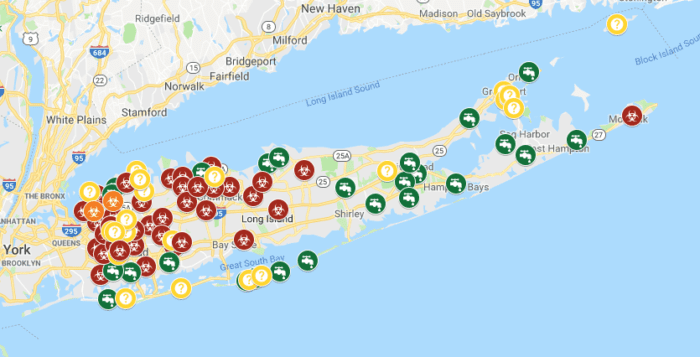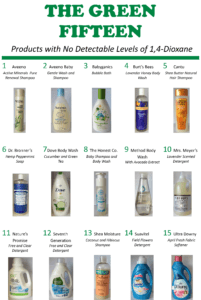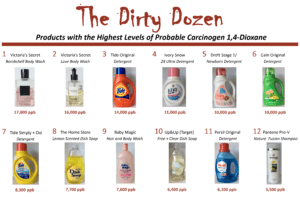1,4-dioxane chemical a concern on Long Island

Many have attributed New York state of having “the champagne of drinking water,” though in recent years concerns over water quality have grown, especially on Long Island.
After toxic chemicals have been found in Long Island’s drinking water, 1,4-dioxane, has been found to be the chief concern on the Island, and currently it is not regulated by the state.
The chemical has been designated by the U.S. Environmental Protection Agency as a likely carcinogen associated with liver and kidney damage after a lifetime of exposure to contaminated drinking water.

In March, 1,4-dioxane was found in private drinking wells of two homes on Oakside Drive in Smithtown where results showed concentrations higher than 1 part per billion, which is the proposed recommendation by the New York State Drinking Water Quality Council in December 2018. It is not a definitive standard, and the state Health Department is expected to propose a water standard for 1,4-dioxane in the near future.
As a result of the uncertainty surrounding the Island’s drinking water, the Suffolk County Department of Health Services, beginning on March 25, sent informational letters and planned on visiting the 29 homes served by the wells along Smithtown’s Landing Avenue, Oakside Drive and Valley Avenue. From there, each homeowner would set up an appointment with the SCDHS and its staff will come and secure water samples from the wells.
Grace Kelly-McGovern, public relations director at SCDHS said as of April 10 every homeowner received a letter regarding the surveys and 15 of the wells at these homes have already been sampled. Three more homeowners have requested samplings, but the department has yet to receive a response from the other 11 homeowners.
According to Kelly-McGovern, once the samples are collected, they will be sent to the Hauppauge SCDHS lab, along with the New York State lab in Wadsworth, and will be tested for 1,4-dioxane and other contaminants. The process should take one to two months. She added it could take several months until homeowners are notified of the results of the samples.
A concern of 1,4-dioxane is that it can’t be removed through conventional treatment methods and involves a complex process of mixing the contaminated water with hydrogen peroxide, treated with ultraviolet light and then gets sent to tanks filled with carbon where the rest of contaminants are filtered out. The Suffolk County Water Authority’s Central Islip treatment system currently has the sole advanced oxidation process system capable of removing 1,4-dioxane on Long Island, though it required state approval to get it.
At a forum in early February, the Long Island Water Conference estimated the cost of treatment systems for close to 200 water wells contaminated by 1,4-dioxane to be at $840 million. Implementing these treatment systems, they said, could lead to higher water rates for homeowners.
The conference coalition asked for additional state aid and for a delay in when they would have to meet the standard.
As the issue for Long Island’s water providers continues, the SCWA board voted to create the first tiered-rate structure in the agency’s history April 1.
The new rate structure took effect the same day and the base drinking water charge for all customers will increase from $1.95 per thousand gallons to $2.028 per thousand gallons.

The new tiered rate will be $2.34 per thousand gallons for all consumption over 78,540 gallons per quarter. Customers will only pay the tiered rate on water above 78,540 gallons per quarter, and the standard rate up until that point.
According to the authority, the action is in accordance with an initiative undertaken by the New York State Department of Environmental Conservation, which established a goal for suppliers of reducing peak season water use by 15 percent by 2021 in order to ensure the sustainability of water resources.
“Conservation rate structures have been adopted all across the country to encourage Americans to adjust their water-use habits for the long-term preservation of available water resources,” Jeffrey Szabo, the SCWA chief executive officer said in a press release. “We expect the new rate structure to help protect ratepayers who are careful in their water use and help provide the continued viability of our aquifer system.”
The 1,4-dioxane chemical has also been found in industrial solvents. A March study released by the Citizens Campaign for the Environment indicates the chemical is present in 65 of 80 household products tested, including baby products, shampoos, detergents and body washes. According to Adrienne Esposito, CCE executive director, the products were tested by the ALS environmental laboratory in Rochester which is certified by the state Department of Health.
The CCE argues that the chemical could end up down the drain and seep into drinking water through septic systems or wells.
Similarly, state Assemblyman Steve Englebright (D-Setauket) has introduced a bill that would ban household products containing 1,4-dioxane in the state except in trace amounts. The bill is currently in committee.
This post has been changed to reflect the accurate location of the SCDHS lab and other lab to be doing the water testing.






